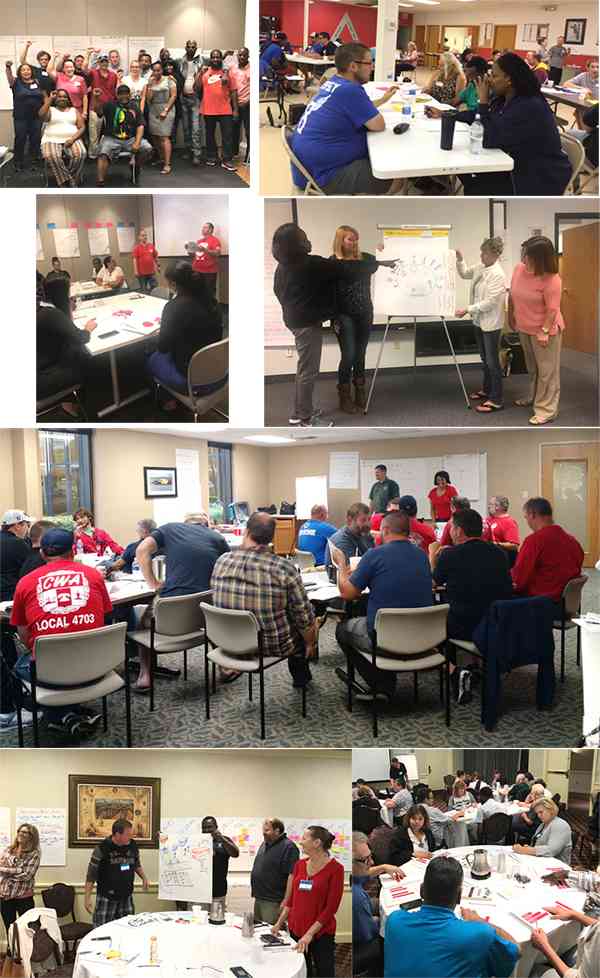
Join the Runaway Inequality Education Network
In recent months, hundreds of people have joined the RunawayInequality.org Educational Network. More are reaching out every day, wanting to teach their co-workers, neighbors, and colleagues about Runaway Inequality, its causes, and what can be done to stop it. Together we can build an educational movement that shines a light on runaway inequality. We can show how our issue silos are deeply linked through the financial strip-mining of our economy.
Reversing Runaway Inequality Workshops
The network runs one-day workshops called Reversing Runaway Inequality. While the full curriculum is designed for a full-day workshop for 20-25 people, the material can be adapted for almost any situation, such as showing one or two charts to a few people during lunch break, or holding a one-hour version of the workshop. All of us in the network need to figure out the best ways to use the curriculum in our communities.
Workshop Curriculum
Reversing Runaway Inequality is a powerful workshop. Trainers find that participants are deeply engaged and hungry for the facts about runaway inequality, its causes, and how it impacts nearly every social and political problem they care about, from worker rights to our mammoth prison population. Most are inspired to bring the information to their co-workers, fellow activists, neighbors, and community members.
Download the workshop curriculum at the Reversing Runaway Inequality resource page. (There are trainer and participant versions of the workbook.)
The workbook is divided up into a series of activities, each of which has one or more tasks for participants to complete in small groups. You can pull out different activities depending on your audience and how much time you have.
No one in the RunawayInequality.org educational network is obliged to use this curriculum, though the workshop materials and training method has been field tested all over the country and it works. If you find better materials, those should be tested as well and the results shared throughout the network. Together we will learn by doing.
Workshop methodology
At the resource page there is also an explanation of the training methodology the workbook uses, called the Small Group Activity method. Again, no one is compelled to use this method, but years of testing have shown that the method extremely effective, especially for complex material such as this.
The method is also designed so that the workshop trainers don’t need to be an expert in the subject matter, though they do need to become familiar enough with the material to facilitate discussions. The workshop tends to work best with two trainers.
Train-the-Trainer
The network is periodically holding train-the-trainer sessions around the country that cover both the material and the Small Group Activity method. Where and when they are held depends on getting a critical mass of people in an area who want to be educators and—this is sometimes the harder part—who will have multiple opportunities to put on the workshop. There will also be experiments with training trainers via webinars and video.
But setting up these train-the-trainer programs take time. So it is hoped that you can bring your skills to bear to use the curriculum on your own and spreading the word.
Finding opportunities to train
Sometimes the harder piece of being a trainer is finding opportunities to actually train people. It’s important that each of us consider what’s realistic for ourselves. Think about what kind of training opportunities you might have: Can you recruit 20-25 people to attend an 8-hour workshop? Once? Two or more times in the next six months?
What about a four hour version of the workshop?
Often the participants are eager to help spread the information and will want to recruit others for future workshops.
Growing the Network
To have an impact on a country as large as ours, we all need to grow the network. Each workshop, each presentation and each educational encounter should encourage participants to join the runawayinequality.org network and help spread the word. We should be encouraging people to join wherever we go. They can go to “Join Us” on the RunawayInequality.org website and fill out the form.
Other ways to be a Runaway Inequality educator
There are a lot of ways to be part of the Runaway Inequality education network besides running workshops:
- Try to get 15-30 minutes on the agenda of activist or community organizations to review the petition and collect signatures.
- Get a copy of the book to arm yourself with some key facts. [order page] Paper and electronic versions are available in English and Spanish. (All the revenue from the books goes directly back into the education network.)
- Pick out a few charts from the book and share them with several different people each week. If thousands of us do that it will make a real difference. [Link Coming Soon.]
- Set up a reading group. We can get you bulk copies at cost. There are discussion questions at the end of each chapter. (20 or more copies for $8/book, including shipping.) [Link to bulk order form]
Building the Network
To have an impact on a country as large as ours, we all need to help build the network. At each workshop, each presentation, and each educational encounter, we should encourage participants to join the RunawayInequality.org education network by signing up at RunawayInequality.org/join-us/.
Finally, please share your experiences [report events] with others in the network so that we can learn from each other. We’ll post them on the News page at RunawayInequality.org website and across social media.
It’s time to build a mass movement powerful enough to reverse runaway inequality, before it tears us even farther apart. Together, we can make an enormous contribution.
We are honored that our materials are supporting these efforts. (All royalties and revenues from the book sales and training programs are being plowed back into the educational campaign.)
Join Us Now!
Receive our monthly newsletter about Runaway Inequality.
